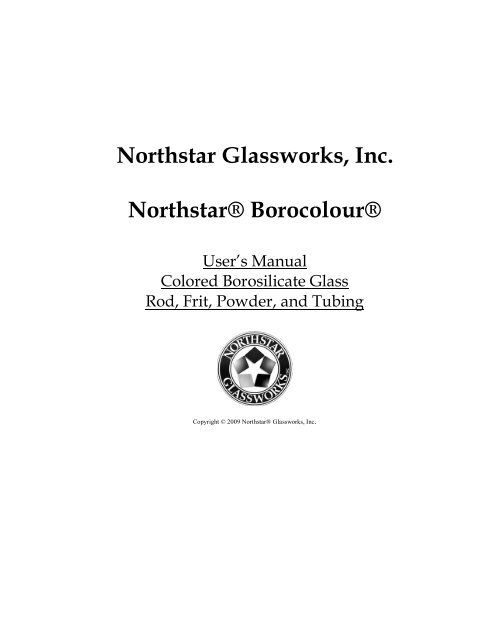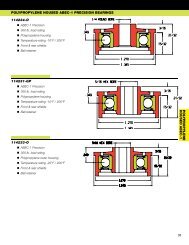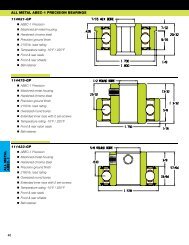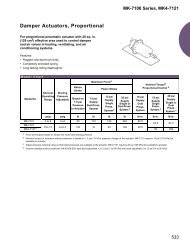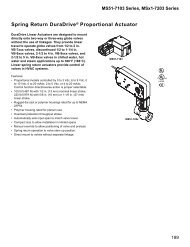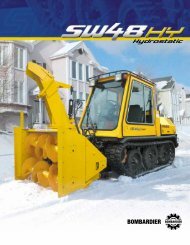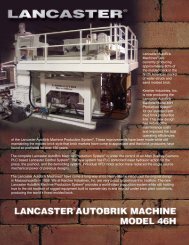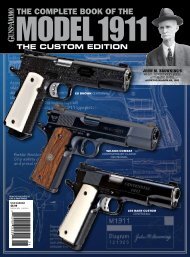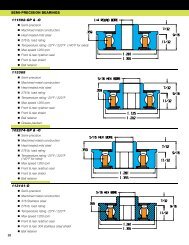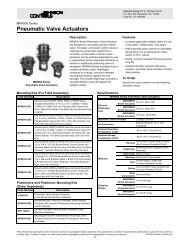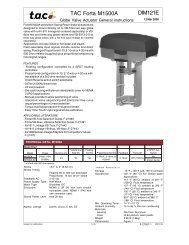Northstar User Manual - Wale Apparatus
Northstar User Manual - Wale Apparatus
Northstar User Manual - Wale Apparatus
Create successful ePaper yourself
Turn your PDF publications into a flip-book with our unique Google optimized e-Paper software.
<strong>Northstar</strong> Glassworks, Inc.<strong>Northstar</strong>® Borocolour®<strong>User</strong>’s <strong>Manual</strong>Colored Borosilicate GlassRod, Frit, Powder, and TubingCopyright © 2009 <strong>Northstar</strong>® Glassworks, Inc.
2Table of Contents- Our Company- What is Borosilicate and how is it unique?- Factors that Affect Colored Borosilicate:- Flame Settings- Annealing- Reduction- Heat Sensitive Colors- The Amber Purple Family- The Exotic Family- The Ruby Family- Using <strong>Northstar</strong> ® Frits & Powders- Using <strong>Northstar</strong> ® Tubing- Health and Safety- Quick Guide to Flame Settings and ColorsOur CompanyWe at <strong>Northstar</strong> are a small team of skilled glass artists and technicians who continue the tradition of making hand-pulled color. All of our rodsare formed and pulled by hand from small batch furnaces to ensure the highest-level color uniformity and quality. Two operators who must workin sequence to produce good quality glass man each furnace. It is a challenging process that requires much practice and dedication. We are proudthat this old tradition lives on in a world with such a high level of automation.<strong>Northstar</strong> Glassworks was founded in the early 1980’s to offer the first commercially available colored borosilicate palette to the lampworkingcommunity. Through the years the color palette has been developed and refined. Under the leadership of Charles Byles between 2001 until hisdeath in 2006, the integrity and quality of our product reached an unprecedented level. Nancy Byles now owns the Company and operates italong with General Manager Abe Fleishman and our team of fifteen. Our color palette has grown to be the most comprehensive and highestquality in the industry. We are proud to offer a fully compatible line of colors with many of the favorite opal hues of the soda-lime palette and awhole array of exciting striking colors, unique to the borosilicate palette to explore. Our color palette currently offers more than 100 colors withour R & D department working on the development of new and exciting additions.What is Borosilicate and how is it unique?Starting in ancient Egyptian times, glass artists worked predominately with soda- lime glass. Soda-lime, also referred to as “soft glass” iscomprised of silica (approx 70%), soda (approx 13%), and lime (approx 11%) as denoted by its name. These ingredients render an easilymalleable glass that has a long work time and a relatively low melting point. Because of these working properties, this soda-lime type glass wasand is commonly referred to as “soft glass.” In the late 19 th century scientists began experimenting with different glass compositions. The fruitsof their labor yielded a typeof glass known as borosilicate. Borosilicate glass as denoted by its name-is comprised mainly of silica (approx 80%) and boron (approx 13%).This type of glass melts at a higher temperature and has a shorter working time. It is an extremely versatile glass that is less dense than sodalimeand because of its molecular structure is also more durable.Thermal expansion is another property that must be considered when discussing the uniqueness of borosilicate. Thermal expansion is ameasurement of linear expansion which denotes how much the glass contracts as it is cooled. Soda-lime glasses are at the highest end of thescale and expand the most as they are heated. This means that as they cool, they contract or shrink at the greatest rate. To prevent cracking, thisrate of cooling must be carefully controlled using an annealing oven. Borosilicate glass, however, is on the lower end of the thermal expansionscale. It expands and contracts at a much lower rate than soda-lime glass and is not as susceptible to cracking problems, even when cooledquickly without kilning. This is why borosilicate is used in the scientific industry as well as for cookware. What this means to the artist is whenplacing borosilicate glass in the flame a rod can be directly inserted into the heat without having to be slowly warmed, as is the case with sodalimeglass. Because of this unique property, borosilicate can be used for large sculptures in which a small section can be worked without theentire piece being hot. It also allows the artist to selectively heat sections of a work or reheat portions without cracking. With soda-lime glass, alarge sculptural work can be very challenging, especially when multiple reheats are required.Factors that Affect Colored BorosilicateThe most unique facet about working borosilicate is the striking color palette. Traditionally, striking colors were those that returned to theiroriginal hue after a period of kilning. Borosilicate striking colors on the other hand can produce an entire range of textures and hues, simplyfrom a single rod. The strikes are repeatable and the colors do not burn out, as is the case with certain soda-lime colors. They are extremely
3versatile, but take careful attention to produce certain effects. In this users manual we will help you tackle these issues and make the process ofcreating these alluringcolors repeatable and straightforward. In addition to the broad overview of working our colors we will focus in on three of the most interestingand challenging color families to work: the Amber Purples, the Exotics, and the Rubies. First, we will discuss the major factors that affectcolored borosilicate:Flame SettingsOne of the most important factors to achieve success in working colored borosilicate is flame setting. In general, the majority of the coloredborosilicate palette is affected by reduction. It is critical to know and understand the flame chemistry to be able to control the color. Whenlooking at flame chemistry there are three categories of flames: reducing, neutral, and oxidizing. There is much subjectivity in defining howoxidizing or reducing a flame is, but it can be judged relatively well by flame color, candle length and the sound.A reducing flame is one in which the gas is not being fully combusted. This means there is not a sufficient amount of oxygen present to burn allthe gas. Its long wispy candles and soft bushy character easily identify this type of flame.A neutral flame is one in which there is an equimolar ratio of propane to oxygen. This means that there is enough oxygen to fully combust allthe gas. A neutral flame is thehottest flame that a torch can put out. In identifying a neutral flame look for the sharpening of the candles and for a bright blue glow. Thisindicates that the flame is neutral.An oxidizing flame is any flame that has an excess of oxygen present. A hissing noise, sharp candles, and a paler blue color easily identify theflame. This flame is cooler than a neutral flame because there is an excess of oxygen flowing though the combusting gasses.Learning and identifying these flames is critical in having good control over the colored borosilicate palette. A good litmus test in learning todial in these flames is by working a piece of NS-27 Green Exotic. Start by dialing an oxidizing flame in, then place the rod in the flame andgather a small glob of glass. Take it out of the flame and inspect the color. If the rod is still black this indicates that the flame is oxidizingenough. Second, dial in a soft reducing flame and work the rod. A metallic sheen should rapidly develop. If this metal deposit occurs when theoxidizing flame was dialed in, this indicates that there was not a sufficient amount of oxygen present. For those just starting out withborosilicate, this is an excellent exercise to practice and get comfortable with the flame.ReductionOnce you are comfortable with the flame settings it is important to know what colors should be worked in what flames. Refer to the providedguide for specific flame settings for a particular color. In general, most borosilicate colors should be worked in oxidizing flames. The Cobaltcolors, the Rubies, and all other striking colors are susceptible to reduction. If worked in a reducing flame for any great duration these glasseswill discolor and lose their appealing hue. With the Cobalt colors, they streak gray, with the copper Rubies they turn a milky red, and with thesilver base colors they turn a foggy cream color. This discoloration is due to a chemical reaction that is caused by un-burnt gas in the flame.What happens is the gas particles search for oxygen in order for combustion to take place. In doing so, it robs the surface of the glass of oxygen.This causes the metal oxides that are bonded to these oxygen molecules to change valence state and deposit on the surface in the elemental formof the metal. This deposit causes the discoloration to occur. By increasing the oxygen content in the flame these problems can be eradicated.This is the key in keeping the colors brilliant and true.Heat Sensitive ColorsThe next hurdle to cross when working with colored borosilicate is tackling the more sensitive colors. This group of colors is sensitive toexcessive and/or aggressive, quick heat. The reason for this sensitivity is the colorant agent used in these glasses. There are many metals such ascopper, cobalt, silver, and chrome that have relatively high boiling point and do not volatilize at low temperatures. These are ideal colorantsbecause once in the glassy state, they take aggressive heat without causing the glass to boil. There are some metal oxides however that haveextremely low boiling points that even when in the glassy state they do not take heat well. Here at <strong>Northstar</strong> we try to chemically minimize theseboiling issues, but there is only so much technology can do to curb the nature of particular metal oxides. These colors must be worked in cool,gentle flames and heated up slowly! In order to do so, start by gently heating the rod in the upperextremities of the flame. Pass it back and forth through the flame so it heats up gently and evenly. As it starts to warm it can be brought downcloser to the torch head, where the heat is more intense. If you notice the surface start to overheat, move out of the hottest part of the flame. Thisis the key to preventing surface scarring. The most challenging of the heat sensitive colors are the Intense Opaques: NS-63 Canary, NS-64 Lava,NS-65 Cherry, NS-84 Goldenrod, and NS-85 Poppy. The other major color family that is sensitive to heat is the NS-54 Star White based colorswhich include: NS-55 Periwinkle, NS-57 Midnight, NS-58 Mint, NS-59 Cranberry, NS-62 Bubblegum, and NS-80 Hyacinth. These colors arefar less sensitive than the Intense Opaques, but must be heated up slowly to ensure they do not boil. Once these colors are applied and gentlysmoothed out they will take more heat without boiling. Refer to the reference guide for additional colors to watch for.
4AnnealingThough borosilicate is far less sensitive to thermal shock than soda-lime glasses it is still crucial for the integrity of the work to kiln anneal. Withsmaller work and less complex vessels flame annealing is a viable option, but with thicker sculptural work or more complex assembled workannealing is crucial. Provided here is an annealing chart that has been compiled to aid you in programming a cycle for your artwork.Borosilicate Annealing ChartTHICKNESS(INCHES)0.125 0.25 0.50 0.75 1.00 2.00 3.00 4.005.006.00Hrs @ A/T0.5 1 2 3 4 8 12 16 20 24Hrs @ A/T– 125 deg0.2 0.5 1.7 3.2 4.5 10 21 38 60 85Hrs @ A/T– 200 deg0.1 0.2 0.5 0.8 1 1.5 3 5 8 11Hrs @ A/T– 350 deg0.2 0.3 0.5 0.5 1 1 2 4 7 10Hrs @ A/T– 550 deg0.25 0.25 0.3 0.5 0.75 1 2 4 5 10TotalHrs1.25 2.25 5.0 8.0 11.25 21.5 40 67 100 140Anneal Time: 1 hour for every 0.25 inches of piece thicknessSoak Time @ A/T – 125 deg: 50% of the Anneal Time for pieces 0.25 inches thick or less.100% of the anneal time for pieces greater the 0.25 inches thickSoak Time @ A/T – 200 deg: 25% of the Anneal TimeSoak Time @ A/T – 350 deg: 25% of the Anneal TimeSoak Time @ A/T – 550 deg: 25% of the Anneal TimeAll temperatures are in degrees F and for 33 expansion borosilicate glass.A/T = Annealing Temperature.Critical temperatures for clear:• Working temperature: 2228 degrees F• Softening temperature: 1508 degrees F• Annealing temperature: 1050 degrees F• Strain temperature: 960 degrees FFor closed forms, assume the wall thickness to be doubled (i.e. 0.125 wall = 0.5 wall for annealing, 0.5 wall = 1.0 wall, etc.).A piece may also be brought to temperatures 100 to 150 degrees above the A/T for a few minutes to improve the vibrancy of certain colors.This does not improve the annealing process.
5As the wall thickness increases, the first soak stage (the soak time at the first temperature drop equal to the A/T minus 125 degrees), becomesmore critical in the overall annealing process. This temperature is just below the strain point and allows the thicker, more complex pieces tocool slowly and come to a steady state before continuing with the ramp down in temperature. Additional soak points allow the piece to cool in acontrolled fashion and to stabilize before continuing the cooling process.The times listed for each of the soak periods includes the ramp down time as well as the time at the new temperature. For example, for a oneinch thick piece, the time at the A/T is approximately 4 hrs. After 4 hrs, reduce the temperature by 125 degrees and allow the piece to soak foranother 4 hrs. Then reduce the temperature again for a 1 hour soak, etc.The schedule is based on clear and may need to be adjusted for the different colors being used. Specifically, metallic based colors may need aslightly higher A/T (maybe 25 degrees). The magnitude of the temperature decrease may need to be adjusted as well. The soak times can alsobe a variable that can be adjusted by color in conjunction or separately with the ramp down temperatures.For non-metallic colors, the soak duration may be able to be reduced and the last one to two ramps eliminated altogether. For pieces that are tobe re-worked, it may be necessary to ramp up the temperature of the piece in reverse order to avoid cracking.The thought being that a piece that can crack during the annealing and cooling process might also crack during re-heating.While having compatible COE’s between the different colors and the clear tubing and rod is of primary importance, similar annealingcharacteristics of the different glass components are also something that needs to be considered. If the annealing temperatures are differentenough, and the cycle is set for a component with a lower annealing temperature, the higher end component(s) may not be fully annealed andtherefore there may be enough residual stress to cause the piece to check either during cooling or at some later date.Colors like Forest Green, Moss, and Blue Spruce all have anneal and strain temperatures approximately 100 degree lower than either the clear orthe other standard colors. This is by design and is accomplished in the formulation process. The softening point of these colors is still the same(approximately 1508) so there will not be any piece deformity even though annealing is occurring 100 degrees above the A/T. These colorswere prone to cracking before the re-formulations about 18 months ago and one of the objectives was to make them more “annealing friendly”.In general, the assumption built into the schedule is that even if the COE’s of the clear and different colors are compatible, the annealingtemperatures may not be. If this is the case, care must be taken to minimize/eliminate the possibility of cracking by increasing the different soaktimes and decreasing the temperature drops between each soak. An additional soak period may also be necessary with some colors.Other factors that can increase or require changes to the annealing cycle include:• The piece complexity and amount of sharp angles (design induced stresses)• Thickness variation within the piece• Thermal gradients in the annealing kiln itself (more pronounced in larger kilns)• The absorption characteristics of the colors used (variation in the absorption of light in the different spectrums and how this affectsradiant cooling/heating rates)• The amount of re-work and extended heating and coolingThe Amber Purple FamilyOne of the most elusive and alluring set of colors in the borosilicate color palette is the Amber Purple family. The base formulaic origin of thiscolor family was developed by Suellen Fowler while at Pepperdine University and passed on to the founder of <strong>Northstar</strong> Glassworks. TheAmber Purples are known for the wide array of effects that they produce in many different applications. They truly epitomize the uniqueness ofcolored borosilicate striking colors. This color set consists of NS-13 Amber Purple, NS-26 Double Amber Purple, NS-48 Light Blue AmberPurple, NS-49 Dark Blue Amber Purple, and NS-69 Green Amber Purple. Each is designed for a particular application and strike characteristic.NS-13 Amber Purple-the original shade-is best suited for thick blown work and sculptural work. This is also the case with the NS-48 Light BlueAmber Purple. The other three shades, (NS-26 Double Amber Purple, NS-49 Dark Blue Amber Purple, and NS-69 Green Amber Purple) aremore versatile. The darker shades can be used for sculpture, but they can be stretched much further, making them more suitable for thinnerapplications. For color tips and suggestions visit our website and call for a complimentary brochure with a step-by-step guide to working theAmber Purples.The first and most key variable in achieving a purple strike is how the flame is set. Never work the Amber Purples in a reducing flame. Set asharp oxidizing flame to work these colors. If the flame is not oxidizing enough the color will opacify and turn a milky yellow. When firstheating the color you will notice that there is a metallic haze that precipitates on the surface. This is reduced silver metal that leaches out of thebody of the glass and deposits on the surface. If the piece is worked before all the haze is heated off, the layer of metal will thicken and turn amatte gray color, thus masking the true color. In order to achieve the purple strike once the Amber Purple is applied it must be heatedaggressively with a strong sharp flame in order to remove the initial metal deposit. Turn the work slowly in the flame so the heat scrubs thesurface of all the haze. The surface must be heated to the point that it almost boils. Even if the flame scars the color it will melt back in andsmooth over. This is the crucial step in the whole procedure. Once the initial layer of haze is removed it will re-develop, but not to the extent ofthe initial buildup. The redevelopment of the haze can be burned off easily without the extreme heat. With the more intense Amber Purples (NS-26 Double Amber Purple and NS-69 Green Amber Purple) more vigilance must be kept because the haze will redevelop more quickly.When striking the Amber Purples there are two options, flame or kiln striking. To maximize the strike all the haze must be burned off. To flamestrike, allow the piece to cool for twenty seconds so that there is no more heat glow. Then, bathe the piece in a soft neutral flame so that the
6surface barely glows. To darken the color, repeat the heating process. By heating for short increments of time, the color can be struck to thedesired hue with a greater degree of accuracy. If the color is heated too aggressively, it will over-strike and perhaps the haze will re-deposit.Flame striking is best suited when a color gradient is desired. To achieve a uniform color all the way through the work, kiln striking is the bestoption. When kiln striking, place the un-struck (haze free) Amber Purple in the kiln and hold the work at 1125-1150 for approximately sixtyminutes or until it reaches the desired level of intensity. Note, some thinner work may slump at these temperatures so be vigilant.The Exotic FamilyThe next set of colors that we would like to give you a helping hand in using is the Exotic colors. This family consists of NS-27 Green Exotic,NS-28 Blue Exotic, NS-29 Red Exotic, and NS-47 Aurora. These are the most saturated striking colors on the market and must be worked on asuper-oxidizing flame to prevent them from reducing. They are also sensitive to heat, so work them slowly and gently. In general, the way toattain the brilliant mirror-like sheen strike these colors can yield is to work them in an oxidizing flame until the work is complete. Then bathethe piece in an extremely reducing flame for only a few seconds. Another method of working these colors for other interesting effects isreducing the color, then encasing in clear. Dragging the clear over the surface can also produce interesting patterns with these colors. Overall, allbut the NS-29 Red Exotic do not strike or change in the kiln and are controlled solely by flame chemistry. The NS-29 Red Exotic darkens andwill produce a red hue when kilned. Out of this family, the NS-47 Aurora is the most diverse and produces the most unique shades. It is a lot offun to experiment with. Note that because these colors are evenly saturated with metal oxides, they must be annealed with care to preventcracking. In addition, heavy encasement of these colors is not recommended.The Ruby FamilyThe final color family that we will discuss is the Ruby family. <strong>Northstar</strong>’s Ruby family is extremely diverse and each of our reds has beencarefully formulated for a specific application. At the inception of our company we developed and released three shades of our original formulaRuby: NS-07L Light Ruby, NS-07 Ruby, and NS-08 Dark Ruby. When working these Rubies do so in a neutral to oxidizing flame. Whenheated, they un-strike to a transparent state. When re-heated, these reds start to return to their original red color. NS-07L is the lightest and willonly slightly strike back to its red color in the flame. It is best to kiln strike NS-07L Light Ruby and NS-07 Ruby. This allows the most uniformand even red to be achieved. NS-08 Dark Ruby-because of its intensity-it will strike easily in the flame or in the kiln. You should note that withthese reds over-striking could occur which yields a dull opaque livery red. This can happen by working them too long in the flame or by kilningthem too long. When kiln striking these reds, do so by soaking at 1050 deg F until the desired darkness is achieved. In regards to theapplications for these Rubies, NS-07L Light Ruby is best suited for sculptural work, NS-07 Ruby is best suited for blown work, and NS-08 DarkRuby is best suited for thin applications.The next generation of Rubies came with the release of NS-82 Ruby K. This red stands out from the rest because of its high optical purity. It canbe stretched thin without small bubbles or imperfections causing the surface to pucker. It is designed to be worked long and hot without livering.NS-82 Ruby K is also easier to un-strike back to the clear state, and offers a more uniform strike. This particular Ruby is excellent for sculpturalwork and blown work. NS-82 Ruby K was designed to be kiln struck. This is done in the same manner as with the original Rubies. The majordifference is how NS-82 Ruby K behaves in the kiln. By varying the strike time this Ruby can yield shades ranging from NS-07L Light Ruby allthe way to NS-08 Dark Ruby. It does not over-strike or liver if put into the kiln in a clear state. If the piece is not clear it can liver as severely asthe original Rubies. It can, however, be kilned for a far longer duration of time than the standard Rubies.The most recent addition to our line of Rubies is the self-striking Ruby family. This family is comprised of: NS-86 Garnet, NS-87 Garnet Dark,and NS-88 Pomegranate. When working the self-striking Ruby, work in a hot neutral to oxidizing flame. You will note that as the glass heats upit will turn clear just like a standard Ruby, but as it cools down it will strike to a specific shade that is dependant on its copper concentration.Thickness also plays a role in how the final color appears, yet evenwhen thinned they are much cleaner, less bubbly, and a more consistent red.Repeated striking and cooling should not result in a shade change or browning specifically with the NS-88 Pomegranate. However, with the twodarker shades NS-86 Garnet and NS-87 Garnet Dark, a brown hue can develop in certain applications such as I/O work, thin work, or work inwhich the heat application is uneven or limited. In sculptural applications the two darker self-striking Rubies approach a deep shade ofburgundy.As with the standard Rubies, the self-striking Rubies have been designed for specific applications. The lightest of the three, NS-88 Pomegranate,is best suited for sculptural applications. It is also ideal for mandrel wound beads. This is because it has the lowesttendency to develop a brown hue. Because of its intensity, it will not fully strike on its own and the strike must be finished in the kiln at 1050deg F. NS-86 Garnet, the medium strength self-striking Ruby is best suited for medium thick blown work and some thin sculptural applications.It will fully strike on its own. NS-87 Garnet Dark is designed for thin blown work, stringers, and lip wraps. It is not necessarily recommendedfor certain thick sculptural work because it can easily yield a deep burgundy brown color.Using <strong>Northstar</strong> ® Frits & PowdersThe term "frit" refers to granular crushed glass. Soft glass frits have been available to glass artists for a long time in many colors and severaldifferent mesh sizes. Furnace working glassblowers and European-style lampworkers use frit regularly as a means of adding color to their work.Frit can also be used in such techniques as Pate De Verre and fusing.
7We offer many of our borosilicate colors in powder and frit form. Size Large frit is coarse; approximately .055 inches or 1.397 mm. Size Smallfrit is finer, approximately .024 inches or .6096 mm. These frits and powders have been formulated for use with Pyrex ® , Duran ® , Kimax ® ,<strong>Northstar</strong> ® or any other glass with a similar coefficient of thermal expansion (33). Using frits and powders provide the hot glass artist with ameans of adding color and/or texture to a piece quickly and easily.There is no "right way" or "wrong way" to utilize frit or powder. Experimentation will lead to discovering your own unique effects and subtlerefinements of techniques. The basic idea is to get the frit to stick to a target object. In order for this to occur the temperature of the object mustbe hot enough to be soft (at least on the surface of the glass). The hotter/softer the target object is, the more readily the frit will stick to it. If theobject has already been formed and slumping is not desirable it is better to heat the object just enough for the frit/powder to begin sticking (bypreheating the frit in your oven, the target object can be slightly cooler and therefore less likely to slump). Successive layers can then be built upif a heavy coating is desired. A light sprinkling of frit may be used as a subtle highlight of brightly colored dots or a substantial layer of colorcan be built up giving a more uniform or darker look. Frit can be coated on the outside of solid or hollow objects. It can also be coated on theinside of hollow forms. Frit may be fused in completely or left partially raised for a surface texture. A sprinkling of frit may also be mixed intothe body of a solid gather of glass, giving the entire gather color. NS-00 Clear frit may be added over a colored object for effect. Different colorsmay be mixed for a custom look.ApplicationAfter first heating the "target object" hot enough so that frit or powder will stick to it, here are some possibilities.ROLL METHOD: Put the frit/powder into a bowl or on a plate and then roll or dip the target object into the frit/powder. The piece should berotated for an even coating. Repeat as many times as necessary to achieve the desired effect.SPRINKLE METHOD: Frit may be sprinkled over your object either with a spoon or with the fingers. When using this method it is wise toplace a clean plate or container under the work area to collect any frit that does not stick (invariably, some frit will not adhere the first time).Remove the object from the flame before sprinkling frit. Sprinkling directly through the flame is not recommended since the flame will blowsome of the frit away. This is not only a waste of good frit but can cause a dust problem in your shop (see health precautions below).TUBE METHOD: Frit or powder can be fused to the inside of a hollow object by sprinkling it into a rotating tube. Using this method thefrit/powder may be added either before or after the object has been heated. This method can also be used when applying frit to tubing in aglassblowing lathe.ROD METHOD: A clear or colored rod may be heated (usually the tip, coated with frit (roll method), and then applied in the usual manner. Thisis a very quick and easy method of adding color.Working In the Frit and PowderOnce the desired amount of frit or powder has been deposited onto the object, use a relatively cool flame to fuse it in. Use a cool flame becausethe glass is in the form of small particles and, until they are mostly fused in, are little bumps on the surface of the glass, easily caught by theflame and super heated to a boil, which could cause a rough texture. A hot flame may be used but the object should be passed quickly throughthe flame so as to heat the frit more gradually. Working in the tip of the flame can help. While some colors may vary slightly in appearance fromrod to frit/powder, most will retain there working characteristics i.e. striking, oxidation/reduction.CAUTION: AVOID EXPOSURE TO GLASS DUST. ALWAYS USE A DUST MASK AND EXHAUSTHOOD WHEN HANDLING FRIT AND POWDER.These notes are intended as a general guide. Individual results will vary depending upon many factors including type of gas used (i.e. propane ornatural gas), type of torch used (surface or internal mix), type of annealing oven used (gas or electric), and the sequence of heating and cooling.Individual batches of color may vary slightly, as all the color is hand made. <strong>Northstar</strong> ® Borocolour ® should come to you pre-labeled for easyidentification. Please be sure to store your glass colors in a manner that allows you to identify which color you are using and which colors toreorder.If you should experience a problem with any of our colors please e-mail or call technical support. We want to know what your experience iswith our colors. Your feedback will help us to continually improve our products.Experimentation is the key to diversity as well as the best way to master the use of <strong>Northstar</strong> ® Borocolour ® BorosilicateColor Glass.Working hand pulled Tubing by <strong>Northstar</strong> ®T013-Amber Purple hand pulled color tubing is the first in our new Tubing by <strong>Northstar</strong> ® line. Work the tubing just like youwould the rod form. We recommend pre-heating each tube in the kiln at 1050f for at least 20-30 minutes before using in the torch.This will ensure that there is no loss of tubing from thermal shock. Since the tubing is hand pulled, the sizing will vary. Our
8target size is 19-26mm diameter and 2.5-5.0 mm wall but you will find variation from tube to tube and may see tapering at oneend due to the hand pulling process. T013-Amber Purple tubing will give a very consistent strike with no coil lines or air bubbles.Work in an oxidizing flame for purples and wispy greens and blues. Use a reducing flame to achieve milky, creamy hues. T103Amber Purple Tubing can be struck in the kiln or the flame depending on the color you want to achieve. Anneal in the same wayyou would anneal a piece made with rod. Refer to the Amber Purple section of this <strong>User</strong> <strong>Manual</strong> for more in depth information.Health & Safety GuidelinesLike any craft or hobby, glass working has some inherent risk of injury to the artist. As interest in lampworking has increased, it has becomeclear that general information on potential health and safety risks would be useful. The following information is intended to increase yourenjoyment of lampworking, while adding to your awareness and helping you reduce your exposure to potential hazards. These suggestions havebeen prepared and reviewed by a group of experienced lampworkers.Eye ProtectionEye protection is very important in lampworking, for two reasons. First, glass can sometimes shatter when placed directly in the flame, and youmust protect your eyes from flying glass fragments. Goggles or glasses with side shields are good for this. You must also protect your eyes frompotentially damaging Ultraviolet and Infrared rays, which are emitted when you melt glass in a flame. For many years, the standard eyeprotection for lampworkers has been “didymium” glasses, which have the additional feature of filtering out the distracting yellow glare given offby molten glass. In recent years other types of protective eyewear have become available, some of which are superior to traditional didymiumglasses. The type of protective eyewear that is right for you depends on the type of glasswork you will be doing. For instance, making beadswould give off less radiation than working a large piece of borosilicate tubing, which in turn gives off less than melting fused quartz. Also,different people may have different sensitivity. Please protect your eyes. Check with your supplier and other reliable sources for moreinformation on choosing eye protection.Respiratory HazardsMelting glass in a flame produces a number of gasses and vapors that can affect your health. It is important, therefore, to ventilate your workarea. At the very least, you should provide “dilution ventilation”, in which a steady stream of air flows across your work area, drawing anyvapors or gasses away from your face and out of the room. Windows at opposite ends of your work area, one of which has an exhaust fan, canbe an effective form of dilution ventilation. Some lampworking operations may require “local exhaust ventilation,” such as a fume hood, toeliminate hazardous or irritating vapors and gasses. If you find that you feel slightly short of breath or that you have a headache at the end of awork session, then you can be certain your ventilation is inadequate.An additional respiratory hazard is posed by glass dust particles you might encounter in your studio or work area. These include powdered“bead release” compounds, the dust stirred up when you work with vermiculite and loose particles of refractory materials such as brick orceramic-fiber insulation inside your kiln. Take care not to inhale these irritating and potentially harmful dust particles. Wear a respirator ifnecessary to reduce your exposure. Be aware of hazardous dusts that can be stirred up when you are cleaning your studio. You can also use awet/dry shop vacuum to pick up glass particles or use a sweeping compound made for fine particulates, in order to keep the glass dust fromrising up off the ground. Wet down any questionable areas or spills with a spray bottle before wiping with a wet rag, to reduce the chances ofinhaling particles. If you sandblast your finished pieces, follow all safety guidelines appropriate to sandblasting.Cuts and BurnsThese can be avoided with common sense and care. The most common minor burns occur when someone picks up the end of a glass rod or tube,forgetting that it is hot. A simple system, such as always laying the hot end of a rod away from you, can help you remember which end to grab.Arrange your work area so that you never have to reach in front of your torch to get a tool or piece of glass. Choose your work clothes carefully,avoiding synthetic fibers, long loose sleeves, and shirts with open pockets or pants with folded cuffs.Burns can be treated with ice, aloe vera sap, cold cider vinegar, or a variety of home remedies. Treat your injuries with respect; serious cuts orburns may require professional medical attention.Tanks and TorchPotential hazards also exist any time you work with compressed gasses. Carefully follow any manufacturer’s instructions that come with yourregulators or gas tanks and check with your suppliers for safe operating procedures.Never move oxygen tanks without their protective cap in place. If the tank falls over, the valve stem can be sheared off by impacting against atable or other object. The pressure inside the tank may then be high enough to send the cylinder flying like a rocket, injuring you and damagingyour building. Oxygen tanks should be either laid on their side and secured to prevent rolling, or chained securely to a wall so they don’t fallover. Note also that oxygen regulators, hoses and fittings should never come into contact with grease or oil, which can ignite spontaneously inthe presence of pure O 2 .
9Be sure to install check valves and flashback regulators on your fuel, gas and oxygen regulators to prevent backwards flow of gasses-a majorhazard in the event of a fire or torch malfunction. Make sure that your torch is secured to the work surface so that it doesn’t move if a hose isyanked. Keep all flammable and combustible materials well away from your torch. At the end of each work/play day, shut off your oxygen andgas tanks and bleed the pressure out of the lines by opening your torch valves.Other HazardsThese can include muscle strains or other injuries from maneuvering heavy oxygen tanks or repetitive movements (such as making hundreds ofbeads). Take frequent breaks and pay attention to your body’s signals to minimize these types of injuries. Check for accurate height of table tochair for comfortable work. Dehydration and heat exhaustion are other possible hazards to watch out for. Drink plenty of water, especially if youare working with a large flame. You may also consider applying a sunscreen to your skin to protect it from the radiation given off by the flame.The following references may be useful in protecting yourself from the common hazards of lampworking:Artist Beware, by Michael McCann, available from Center for Safety in the Arts, 5 Beekerman St., Ste. 280, New York, NY 10038Contemporary Lampworking, A Practical Guide to Shaping Glass In the Flame by Bandhu Scott Dunham, available from SalusaGlassworks, P.O. Box 2354, Prescott, AZ 86302Glassblowing: An Introduction to Solid and Blown Glass Sculpturing by Homer L. Hoyt, Crafts & Arts Publishing Co. Inc, 626 Moss St.,Golden, CO 80401The Artist’s Complete Health and Safety Guide by Monona Rossol, available from Allworth PressVentilation-A Practical Guide for Artists, Craftspeople and Others in the Arts by Nancy Clark, Thomas Cutter and Jean Ann McGrane,available from Center for Safety in the Arts“Beads from the Beginning” by Brian Kerkvliet, Glass Art Magazine, November/December 1994, P.O. Box 260377, Highlands Ranch, CO80126“F.Y. Eyes” by Lisa M. Malchow, Fusion Journal of the American Scientific Glassblowers Society, May 1993. 1507 Hagley Rd., Toledo, OH43612“Glassmaking Health and Safety” by Monona Rossol, Glass Art Society Technical Journal, 1989. Reprint available from Allworth Press“Optical Radiation Hazards in Glassblowing” by Gary E. Myers, Fusion Journal of the American Scientific Glassblowers Society, August1976This information is offered as a starting point for your own safety research, and new information may affect the appropriateness of theserecommendations. The suppliers of this information assume no liability for any injury or harm which may result from use or misuse of thisinformation. Be sure to consult with your supplier, physician, or other qualified expert regarding any safety questions you have.Quick Guide to Flame Settings and ColorsNS-01 Cobalt: Can take a lot of heat and can be worked in a wide range of flame settings. Stay out of reducing flames to prevent dulling or graystreaking to occur.NS-03 Multi: When worked in an oxidizing flame this color produces smoky blues and sea greens. When reduced, NS-03 Multi yields earthyreds and gold tones.NS-04 Dark Multi: A more intense version of NS-03 Multi that will yield similar effects, but much more pronounced. When worked in anoxidizing flame Dark Multi produces metallic blues and sea greens. When reduced, NS-04 Dark Multi yields earthy reds and browns.NS-05 Orange: A bright transparent striking orange that is well suited for sculpture, bead work and moderately thin blown work. Work in anoxidizing flame and kiln strike.NS-06 Dark Orange: A more saturated version of NS-05 Orange. It is well suited for thin blown work, cane work, or when a deep semi-opaqueorange is desired. Work in an oxidizing flame. It can be kiln or flame struck.NS-07L Light Ruby: A vibrant transparent striking Ruby. Work in a neutral to slightly oxidizing flame. It is designed to be kiln struck.NS-07 Ruby: A medium intensity-striking Ruby. Work in an oxidizing flame. It can be kiln or flame struck.NS-08 Dark Ruby: The most saturated of the transparent striking Rubies. Work in an oxidizing flame. Designed primarily for flame striking, butcan be kilned as well.NS-09 Yellow: If worked in an oxidizing environment, NS-09 Yellow will yield a transparent golden yellow. If worked in a neutral to slightlyreducing flame NS-09 Yellow will start to darken and opacify. Can be flame or kiln struck.
10NS-11 Jade: Slightly heat sensitive. Work gently at first in a cool oxidizing flame.NS-13 Amber Purple: Work in an oxidizing flame for purples. Reduction yields an opaque milky amber hue. Can be flame or kiln struck. Referto the Amber Purple section for additional information.NS-14 Irrid: A nice medium intensity striking color. Oxidize for metallic blues. Reduce for rich opal sea greens.NS-15 Turquesa: A more saturated version of NS-14 Irrid. Oxidize for smoky blues. Reduce for vibrant greens.NS-19 Light Cobalt: The lightest of the cobalt blues. It is not sensitive to flame atmosphere.NS-20: Dark Cobalt: A rich cobalt blue well suited for blown applications. Work in an oxidizing flame to prevent dulling or graying.NS-23 Pink: A light transparent that is not sensitive to flame atmosphere.NS-24 Transparent Green: A nice transparent shade for sculpture and blown applications. Work in an oxidizing flame to prevent red streaking.NS-25 Peach: A light transparent flesh tone well suited for sculpture. It is not sensitive to flame atmosphere.NS-26 Double Amber/Purple: Work in a hot oxidizing flame. Refer to the amber/purple section for additional information.NS-27 Green Exotic: A high intensity striking color. Slight reduction will yield bright green metallic hues. Prolonged exposure will yield earthtones. See Exotic section for additional information,NS-28 Blue Exotic: A high intensity striking color. Slight reduction will yield bright Blue metallic hues. Prolonged exposure will yield earthtones. See Exotic section for additional information.NS-29 Red Exotic: A high intensity striking color. Oxidize for bright metallic reds. Reduce for earth tones. Kilning will yield a darker red. SeeExotic section for additional information.NS-31 Lavender: A light transparent color. It is not sensitive to flame atmosphere.NS-32 Violet: A light transparent color. It is not sensitive to flame atmosphere.NS-33 Turbo Cobalt: The most saturated cobalt blue on the market. Work in a heavily oxidizing flame to prevent graying.NS-34 Extra Light Yellow: A lighter version of NS-09 yellow. It produces a warm hazy glow when reduced or kilned.NS-37 Rootbeer: A unique striking color. Oxidize for greens and gold tones. Reduce for reds and earth tones. It will darken in the kiln.NS-38 Intense Blue/Green: A saturated striking color excellent for encasement. Oxidize for bright opal blues. Reduce for deep smoky greens.NS-41 Butterscotch: A versatile striking color. Oxidize for creamy hues. Reduce for a slight silvery tone and deeper browns.NS-42 Cinnamon: A nice medium intensity brown. It is not sensitive to flame atmosphere.NS-43 Rust: An earthy red color. Work in a neutral to oxidizing flame. The color will strike to a deeper red in the kiln.NS-44 Caramel: A lush bright silvery color. Oxidize for creamy tan hues. Reduce for a bright mirror-like sheen.NS-45 Blue Moon: A saturated striking color. Oxidize for brilliant blues and greens. Reduce for sea greens and matte grays.NS-47 Aurora: An exciting striking color. Oxidize for blues and magenta hues. Reduce for greens and earth tones. For additional informationrefer to the Exotic section.NS-48 Light Blue Amber Purple: Oxidize for purples. Reduce for opaque sea greens. Refer to the Amber Purple section for workinginformation.NS-49 Dark Blue Amber Purple: A more intense version of NS-48 Light Blue Amber/Purple. Oxidize for purples. Reduce for opaque seagreens. Refer to the Amber Purple section for working information.NS-52 Teal: A bright fully opaque blue/green. Not overly sensitive to atmosphere, but work in a neutral to slightly oxidizing flame.NS-53 Forest Green: A bright fully opaque green. Work in an oxidizing flame and heat slowly. It can boil if heated aggressively. See the HeatSensitive color section.
12NS-87 Garnet Dark: A high intensity self-striking Ruby. Work in an oxidizing flame. It will not liver, but it can develop a brown hue ifoverworked. Kilning will not affect the strike. Refer to Ruby section for additional information.NS-88 Pomegranate: The lightest of the three self-striking Rubies. Work in a neutral flame. Will not liver or develop brown hues. The strikemust be completed in the kiln at 1050 deg F. Refer to Ruby section for additional information.NS-89 Nile: An appealing earth tone. Work in a hot oxidizing flame. Burn off haze and kiln or flame strike. Work like an Amber Purple.NS-90 Rhapsody: A nice medium-dark intensity shade of purple. It is not sensitive to flame atmosphere.NS-91 Ninja: A nice opaque blue based black. Work in a heavily oxidizing flame to prevent graying.NS-92 Amethyst: A nice light-medium intensity shade of purple. It is not sensitive to flame atmosphere.NS-93 Plum Krazy: Work in a cool oxidizing flame to keep color un-struck. To strike, either kiln at 1050F or bathe in a gentle neutral flame tobring out a smoky blue hue. Prolonged reduction leads to a grayish blue opaque surface.NS-94 Egyptian White Sand: Not sensitive to atmosphere but must be worked slowly in a soft, unfocused flame to prevent surface scarring andboiling. Once melted in smooth, heat can be soaked in more rapidly.NS-95 Oregon Gray: An atmospherically stable opal. Work slowly in a soft, unfocused flame to prevent surface scarring. Once melted insmooth, heat can be soaked in more rapidly.NS-96 Light Oregon Gray: An atmospherically stable opal. Work slowly in a soft, unfocused flame to prevent surface scarring. Once melted insmooth, heat can be soaked in more rapidly.NS-97 Evergreen: A bright fully opaque green. Work in an oxidizing flame and heat slowly. Color can boil if heated aggressively. See theHeat Sensitive color section.NS-98 Loch Ness: A dark opaque sparkly green. Best if worked in a neutral to oxidizing flame. Extended annealing tends to bring out agolden hue in this color.NS-100 Black Lightning is a very dense black with silver. NS-100 Black Lightning can yield a mirror like blue metallic finish or if over-reducedan organic earthy tone. To keep the Black Lightning most vibrant, work in a super oxidizing environment until you are finished with the piece.Then, turn the flame down and bathe the piece in a super reducing flame for several seconds to produce the mirror like sheen. For another greateffect, encase NS-100 Black Lightning with clear. This color can be stretched out and is great for blown work. If heavily encased, be sure toanneal thoroughly. This is the bigger brother of NS-111 Alaskan Thunder.NS-101 Purple Urple is a dark purple that looks like NS-80 Hyacinth but works differently in the flame. This opaque purple uses chrome basedtechnology but does not have cracking problems. It is great for blown work and thin stringer application. It is heat and flame sensitive so it mustbe heated up slowly to prevent boiling. Once it glows red, NS-101 Purple Urple will take heat well. Because of its intensity it is sensitive toreduction. If the flame is not oxidizing enough, gray and brown streaks will develop on the surface of the glass. Try it with a layer of NS-32Violet for a deep purple effect.NS-102 Silver Bullet is a look alike of NS-44 Caramel. It is a rich silvery tan color that can be stretched out thin. It is great for stringerapplication and blown work. Work in a hot neutral to oxidizing flame for bright tan colors. To bring out the silvery mirror like sheen, bathe thepiece in a reducing flame. Try NS-07 Ruby or NS-13 Amber Purple over NS-102 Silver Bullet.NS-103 Berry Gumbolt is a fully opaque saturated dark blue. It is well suited for stringer application and blown work. It is not susceptible toreduction and is not flame sensitive. For best results keep it in a neutral flame. It is a great backing for such colors as NS-14 Irrid and NS-15Turquesa, and goes well with NS-63 Canary.NS-104 Unobtainium is a very dense gun metal blue with lots of sparkle. It is well suited for stringer application and blown work. It is easilyworked and can take a lot of heat. To keep the color most vibrant, work in a neutral to slightly oxidizing flame. Try to avoid deep encasement, itmay cause cracking. Please use NS-104 Unobtainium with care and test your application before making expensive pieces. Outside work seemsto work just great with no problems. Try coating NS-104 Unobtainium with NS-86 Garnet or NS-88 Pomegranate to achieve a brilliant rubysparkle. Any transparent color coated over NS-104 Unobtainium looks great.NS-105 Silver Creek is a silver based color which produces the most exciting metallic purples and vermilions as well as silvery greens andblues. It is a very stable color. It behaves similarly in the flame as NS-13 Amber Purple and NS-26 Double Amber Purple, but because of itsgreater core range, more care has to be taken to prevent reduction and boiling. NS-105 Silver Creek can be stretched and can be blown relativelythin without losing the vibrant colors. Try using with other colors to achieve multi layered color combinations.NS-106 Dark Amethyst is a light transparent violet color. This is a “what you see is what you get” color. Use in a slightly neutral to oxidizingflame for best results. NS-106 Dark Amethyst works like butter so do not hesitate to spread it over other colors. The color looks best in solidcolor blowouts and sculpture work. Stringers tend to lose color and may appear as a clear Violet.
13NS-107 Green Tea is a transparent algae green color with no red reduction. Use in a hot oxidizing flame. NS-107 Green Tea is great for colorcoils and sculpture work. When pulled into stringers, the color fades easily. This is a chrome based color so please use with a little caution toavoid cracking.NS-108 Blue Velvet is a deep navy blue color with small amounts of sparkle. Use in an oxidizing flame to cut down on any reduction from theheavy cobalt content. This color works great in all applications. Chrome is the ingredient that makes the sparkle so please use with caution.NS-109 Plum Kush is a black sparkle. It is well suited for sculptural applications and blown work. It is creamy and works easily. When workingNS-109 Plum Kush, do so in an oxidizing flame. A reductive environment will cause gray streaks to develop on the surface and will result in adull matte finish. When applying the color, do so gently. After it is melted in, it can take a lot of heat. This is the first black sparkle introduced tothe colored borosilicate palette and is a welcome addition to the palette of blacks from which to choose.NS-110 Blue Metal is the bigger brother of NS-108 Blue Velvet. It has more sparkle and is more dense in color. Use an oxidizing flame to cutdown on any reduction from the heavy cobalt content. This color works great in all applications. Chrome is the ingredient that makes thesparkle so please use with caution.NS-111 Alaskan Thunder is a black blue silver color. When worked in an oxidizing flame, NS-111 Alaskan Thunder yields bright metallicblues, greens, and purples. When worked in a neutral flame it yields bright hazy green, white, and cream colors. When worked in a heavilyreducing flame NS-111 Alaskan Thunder produces a nice ash gray. It is well suited for stringer application, blown work, and sculpture. Tryencasing NS-111 Alaskan Thunder with clear or NS-09 Yellow for great effects.NS-112 Mother of Green Pearl is a mossy green sparkle color. It is a bright semi opaque aventurine color. It is suitable for blown work andsome stringer applications. Even when thinned, it will remain sparkly and bright. Work in a neutral to slightly oxidizing flame. If worked in areducing flame the color will not develop reddish streaks. Be sure to anneal thoroughly when heavily cased. This color is Chrome based soplease use caution.NS-113 Turbo Amethyst is a smooth dark violet. This color is an intensified version of NS-106 Dark Amethyst. This is a “what you see is whatyou get” color that works like butter. Use in a slightly neutral to oxidizing flame for best results. NS-113 is the violet version of NS-33 TurboCobalt.NS-114 Tan Silver Creek is a yellowish cream color. It can yield rich purplish blue and creamy tan tones. When kept in a more oxidizingenvironment, you will get more of the blues and purples. If reduced, a silvery haze will appear on the surface. NS-114 Tan Silver Creek is easyto work and can take a lot of heat which makes it a forgiving striking color. It can be stretched out and is good for blown work and sculpture. Ifyou are looking for something even more intense, try NS-44 Caramel or NS-102 Silver Bullet.NS-115 Silver Sea Weed is a funky green color. It is a wild silver striker that can take a lot of heat and be used in many different applications.Working in an oxidizing flame will yield intense purple hues that are like northern lights. If reduced this color will inherit wispy cream colorswith a tint of green.NS-116 Silver Pearl is a green color with a splash of mossy sheen on the surface. This is just like NS-115 Silver Sea Weed, but with a mossysheen. Use in a hot oxidizing flame. NS-116 Silver Pearl is great for color coils and sculpture work. When pulled down into stringers the colorfades easily. This is a chrome based color so please use little caution. In an oxidizing atmosphere this color will turn purple, green, blue, andeven jadish green. If reduced you will get green cream colors and also purple.NS-117 Millennium Falcon is a transparent green sparkle. It is suitable for blown work and some stringer applications. When thinned, it willremain sparkly and bright. To keep NS-117 Millennium Falcon a pure green, work in a neutral to slightly oxidizing flame. If worked in areducing flame it will develop reddish streaks. Be sure to anneal thoroughly when heavily encased. This color is a transparent version of NS-73Millennium Moss. NS-117 Millennium Falcon works great for coating other colors to make a fast sparkle.NS-118 Obtainium is a blackish to grayish sparkle color. Use a neutral to oxidizing flame for best results. This is a “what you see is what youget” color. To avoid fading, try to avoid overheating. NS-118 Obtainium is a chrome based color so please use caution. You will be amazed atthis color. It is one of our favorites.NS-119 Super Unobtainium is a dark blue sparkle. This color has lots of large crystals of metal on the surface. It is well suited for stringerapplication and blown work. It is easily worked and can take a lot of heat. To keep the color most vibrant, work in a neutral to slightly oxidizingflame. Try to avoid deep encasement as it may cause cracking. Please use NS-119 Super Unobtainium with care and test before you make anything that is expensive. Outside work seems to work just great with no problems. Try coating NS-119 Super Unobtainium with NS-86 Garnet orNS-88 Pomegranate to achieve a brilliant ruby sparkle. Any transparent color coated over NS-119 Super Unobtainium looks great. NS-119Super Unobtainium has lots more sparkle but does not have the Gun Metal surface of NS-104 Unobtainium.NS-120 Silver Unobtainium is also a dark blue sparkle that has silver in it. It is well suited for stringer application and blown work. It is easilyworked and can take a lot of heat. To keep the color most vibrant, work in a neutral to slightly oxidizing flame. Try to avoid deep encasementthat may cause cracking. When worked in an oxidizing flame NS-120 Silver Unobtainium stays a dark blue color with wispy hues of silver overit. If reduced the color does not show much sparkle but still has many vivid colors.
14NS-121 Blue Nebula is a dark opaque navy blue color. This color is a “what you see is what you get” color. NS-121 Blue Nebula is easilyworked in all applications. Use an oxidizing flame to cut down on the reduction of Cobalt in the color. NS-121 Blue Nebula holds up verynicely when thinned.NS-122 Blue Thunder is a dark cobalt blue color with silver. When worked in an oxidizing flame NS-122 Blue Thunder yields bright metallicblues. When worked in a neutral flame it yields bright hazy greens. When worked in a heavily reducing flame NS-122 Blue Thunder produces anice ash gray. It is well suited for stringer application, blown work, and sculpture. NS-122 Blue Thunder is a lighter version of NS-45 BlueMoon with the same working values.NS-123 Crystal Bliss is a light cobalt blue with lots of sparkle. The color is not heat sensitive and works great. NS-123 Crystal Bliss is verylight in color and when pulled thin, the color will fade to clear. We created NS-123 Crystal Bliss the artists that like to coat their colors withsparkle. Use an oxidizing flame to cut down on red lines of copper.NS-124 Silver Amethyst is a dark violet color with silver. Work in a cool oxidizing flame to prevent overheating and striking the color. Whenready to strike, either kiln strike at 1050F or bathe the glass in a gentle bushy neutral flame to bring out the soft blue strike. NS-124 SilverAmethyst is best suited for moderately thick coil-potted blown work and sculptural applications. When encased in clear this color produces avibrant violet with wisps of metallic blue. Prolonged reduction leads to a grayish blue opaque surface. Have fun with this color!NS-125 Jet Black is a very dense black. It is well suited for sculptural applications and blown work. It is creamy and works easily, making it awelcome addition to the palette of blacks from which to choose. When working NS-125 Jet Black, do so in an oxidizing flame. If worked in areductive environment it will develop gray streaks on the surface and result in a dull matte finish. When applying the color, do so gently. After itis melted in it can take a lot of heat. NS-125 Jet Black is great in combination with many colors and serves as a background for striking colors.NS-126 Opaque Aqua is a very nice opal blue green color. It is well suited for stringer application and blown work. NS-126 Opaque Aqua willenhance your art because it has a really nice appearance and color. It is not susceptible to reduction and is not flame sensitive. For best resultskeep it in a neutral flame.NS-129 Steel Wool is a unique addition to the borosilicate color palette. It is a funky, bumpy color rod that turns smooth when melted. It hastons of sparkle and can be mixed with any color to add a sparkly shimmer to any piece. NS-129 Steel Wool can be used in all applications without cracking issues, but use caution in deep encasement. We recommend using a neutral/oxidizing flame for NS-129 Steel Wool. Use in theback of the flame and try a reducing flame to cut down on boiling. Try mixing NS-20 Dark Cobalt with NS-129 Steel Wool to get a very niceblue sparkle. A little hand mixing of NS-129 Steel Wool will give you the color you desire. NS-131 English Ivy is a light transparentaquamarine color, that when used in the flame, can yield many color hues. This color is in the same family as NS-13 Amber Purple and NS-03Multi so the color possibilities are endless. NS-131 English Ivy produces metallic blues and sea greens. When reduced, this color can yieldearthy reds and browns. We recommend using an oxidizing flame to achieve the most vivid color. Because it is more saturated than NS-13Amber Purple and NS-03 Multi, it will react much more quickly to the particular chemistry of the flame so be careful not to over reduce. Toyield other interesting effects, try encasing NS-131 English Ivy with clear or backing it with an opaque color like NS-54 Star White. This colorcan be stretched thin, so it is well suited for delicate blown work, stringer application, and cane work.NS-132 Lokis Lipstick is a silver striking color. It is a close companion to NS-13 Amber Purple but with a little more control of the color strike.Work NS-132 Lokis Lipstick in an oxidizing flame to achieve the most vivid color range. It can be struck in the torch or in the kiln. You canachieve colors that look like gold and silver fume and also deep purples. If reduced enough, it will yield creamy yellows and whites. NS-132Lokis Lipstick works well in all applications. It is quickly becoming a must in the artist’s palette.NS-133 Silver Aqua has been formulated at the request of many artists who love the consistency of NS-126 Opaque Aqua and wanted a silverversion to enhance the color spectrum of the piece they are making. To achieve the most vivid color, work NS-133 Silver Aqua in a neutralflame. The hues that can be achieved from NS-133 Silver Aqua range from a deep navy blue and nice blue purples to a whitish yellow hue.
15Please visit our website for lots of additional information including our past Newsletters and great tips on Working our Color.www.northstarglass.com<strong>Northstar</strong>® Glassworks, Inc.P.O Box 230488Tigard, OR 97281-0488(866) 684-6986 toll-free(503) 670-0978 faxsales@northstarglass.comwww.northstarglass.com


